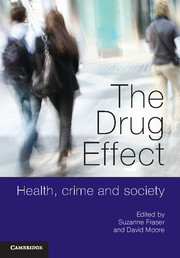Book contents
- Frontmatter
- Contents
- List of contributors
- Acknowledgements
- Introduction
- Part 1 Drug use as social and cultural practice
- Part 2 Drugs, health and the medicalisation of addiction
- 5 Beyond the ‘potsherd’
- 6 Drugs that work
- 7 From ‘magic bullets’ to medical maintenance
- 8 Pharmacotherapy as social policy, or, the public and private worlds of welfare capitalism
- Part 3 Drugs, crime and the law
- Index
- References
8 - Pharmacotherapy as social policy, or, the public and private worlds of welfare capitalism
from Part 2 - Drugs, health and the medicalisation of addiction
- Frontmatter
- Contents
- List of contributors
- Acknowledgements
- Introduction
- Part 1 Drug use as social and cultural practice
- Part 2 Drugs, health and the medicalisation of addiction
- 5 Beyond the ‘potsherd’
- 6 Drugs that work
- 7 From ‘magic bullets’ to medical maintenance
- 8 Pharmacotherapy as social policy, or, the public and private worlds of welfare capitalism
- Part 3 Drugs, crime and the law
- Index
- References
Summary
We begin with the apparent paradox of Sweden and Australia. Australian social policy researchers, especially those who are concerned with poverty, equality and population well-being, are used to hearing (and telling) a familiar story about the difference between Australia and Sweden. The story goes like this: Australia and Sweden are at two ends of the welfare state spectrum. Sweden provides a universal system of cash and non-cash benefits, a system of contributory finance and extensive state intervention to maintain full employment. The most effective test of a commitment to equality and protection against poverty is a country's treatment of those without paid work – typically children, the elderly, people with illness and disability, and their carers. In Sweden, substantial resources are dedicated to these groups. Only 4 per cent of Swedish children live in poverty (3 per cent of households with children), compared to 12 per cent of Australian children (10 per cent of households with children). Adult joblessness is a much greater risk for child poverty in Australia than in Sweden: 13 per cent of Swedish households with children and no working adult are poor, compared to 43 per cent of Australian households. Parental leave after the birth of a baby is offered to Swedish workers for 480 days, the first 390 at 80 per cent of income. Assistance for the elderly is based on an assessment of needs and ranges from home-based care to residential and institutional care, for which recipients pay according to their income and needs.
In contrast, Australia is characterised by a tightly targeted and incomes-tested system of benefits. Universal paid parental leave will be introduced in Australia for the first time in 2011, at a far lower rate than in Sweden. Australia is a low social spender on family benefits and old-age pensions, and poverty rates for older people are among the highest in the OECD (only Korea, Mexico and Ireland have higher rates).
- Type
- Chapter
- Information
- The Drug EffectHealth, Crime and Society, pp. 137 - 152Publisher: Cambridge University PressPrint publication year: 2011
References
- 1
- Cited by

